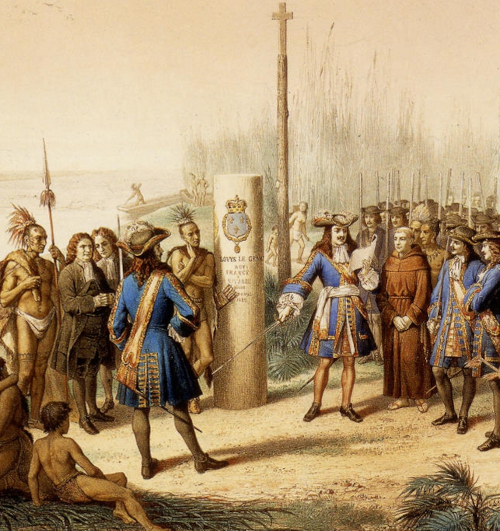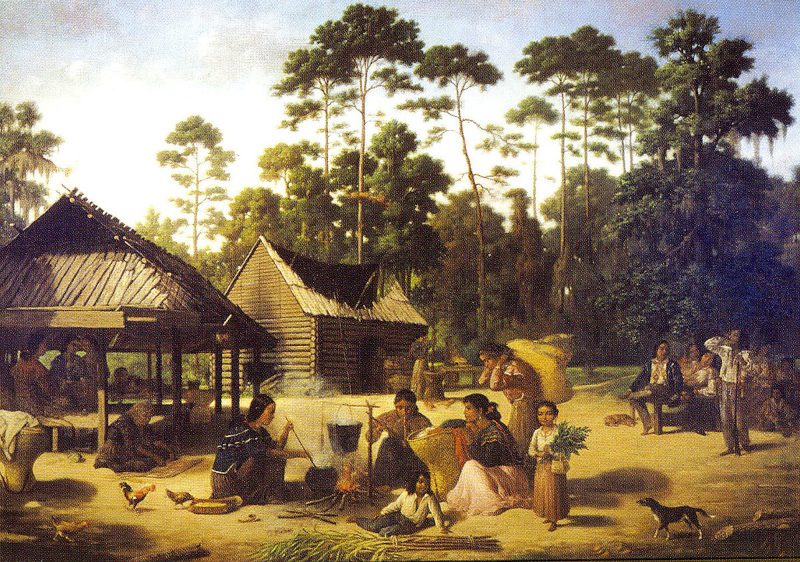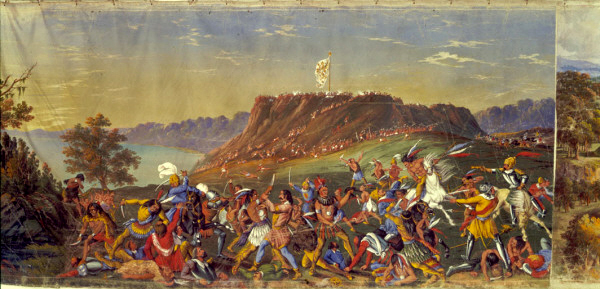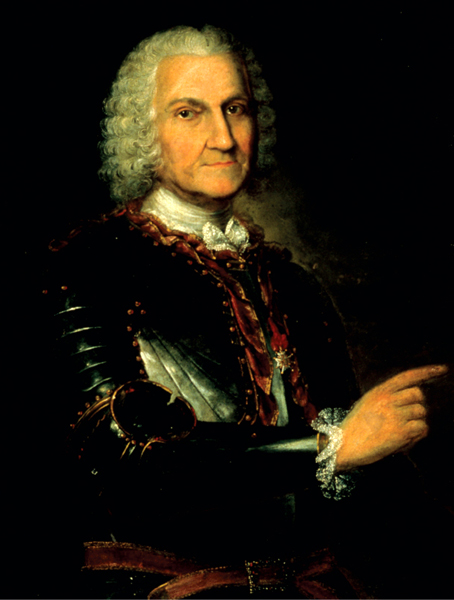 Lasalle claiming the Mississippi Basin for France, detail of 1870s lithograph by Jean-Adolphe Bocquin; image courtesy of Bibliothèque Nationale de France & Wikimedia Commons
Lasalle claiming the Mississippi Basin for France, detail of 1870s lithograph by Jean-Adolphe Bocquin; image courtesy of Bibliothèque Nationale de France & Wikimedia CommonsSometime in April, 1682, René-Robert Cavelier, Sieur de La Salle, reached the mouth of the Mississippi River, bestowed the entire Mississippi River Basin with the name La Louisine, to honor the French king Louix XIV, and claimed it all for France. That included, of course, our Loess Hills.
Moreover, all indigenous Americans in that vast territory were expected to regard the French as something like a benevolent master, or at least an older, wiser brother. The main interaction between the French and the natives became trading. The French traded guns, gun powder, bullets, axes, hoes, textiles, liquor and the like for pelts of fur-bearing animals, especially deer and beaver, which were much in demand in Europe.
 Beaver, fox, marten, wolf and other furs stored at forts before shipping to Europe - 1700s and 1800s; image courtesy Pat G Redhead via Wikimedia Commons
Beaver, fox, marten, wolf and other furs stored at forts before shipping to Europe - 1700s and 1800s; image courtesy Pat G Redhead via Wikimedia CommonsThe natives loved these European goods and in a matter of a few years indigenous-American society went through a profound change. It abandoned much of its traditional, self-sufficient, and sustainable enterprises of hunting, gathering, and farming, in favor of the Europeans' manner of doing business. Also it was the beginning of a problem still haunting native-Ameircan communities: alcoholism. Moreover, the sudden attack on native fur-bearing animals, especially beavers, brought on enormous ecological disruptions. Untold numbers of marshes and lakes created by beaver dams disappeared as the beavers vanished, along with entire marsh and lake ecosystems.
 sketch of Chickasaw person, 1775, by the Dutchman Bernard Romans; public domain image via Wikimedia Commons
sketch of Chickasaw person, 1775, by the Dutchman Bernard Romans; public domain image via Wikimedia CommonsIn 1720 the French were concerned that in the north of their sphere of interest the British were making inroads. In fact, the Chickasaws, living among our northern Loess Hills and farther to the east, favored trading with the English. Not only were the English more accessible because of overland trails to East-Coast English colonies, but British goods were often superior to those of French.
Also, the British paid well for Indian slaves, and the Chickasaw were good at conducting slave raids. In the loess zone the Chickasaws preyed upon the Chakchiuma just to their south. Across the Mississippi River they attacked the farming Caddo and Quapaw, and north of the Ohio River they raided the Illinois.
 Choctaw settlement formerly about 1.5 miles east of Madisonville, St. Tammany Parish, Louisiana; painting 1869 by François Bernard; public domain via Wikimedia Commons
Choctaw settlement formerly about 1.5 miles east of Madisonville, St. Tammany Parish, Louisiana; painting 1869 by François Bernard; public domain via Wikimedia CommonsThe Chickasaws refused to break off contact with the English. Consequently the French sent Choctaw warriors, traditional enemies of the Chickasaws, to raid Chickasaw towns, thus kicking off a long series of struggles historically described as the Chickasaw Wars. The Chickasaws beat off the Choctaw and retaliated against the French by attacking French shipping on the Mississippi River, which went on for nearly four years. The French went so far as to pay the Choctaws a bounty of a gun, one pound of powder and two pounds of bullets for each Chickasaw scalp they brought in. But the Chickasaw held their own and French commerce in Louisiana withered. In 1725, the French sued for peace.
The Chickasaws were not the only indigenous Americans in the loess zone having trouble with the French. The Natchez people had not been particularly pleased with the French for several years. In 1714 the Natchez had become so upset with some French traders that they had killed four. In 1716 the French responded by sending troops into Natchez territory, constructing Fort Rosalie on the loess-topped bluffs, and encouraging French settlers to come and develop plantations on the rich Natchez lands.
Naturally the Natchez resented this, and in 1722 tried to drive the settlers away. Troops suppressed the outbreak, but Natchez anger continued, a third fight occurred in 1723, and finally in 1729, Natchez warriors destroyed several military posts and settlements in their territory, massacred the garrisons, killing 250 Frenchmen and taking nearly 300 women and children hostages. This was the Natchez Revolt of 1729.

The French then attacked the Natchez nation, killing most citizens. Some Natzhez people escaped to go live among other Indian nations, and many were taken by the French as slaves. By 1731 the historical Natchez Indian Nation ceased to exist.
Numerous Natchez refugees went to live among the Chickasaws, who refused to turn them over to the French. This, and the Chickasaws' continued trading with the English bothered the French enormously. The French declared a second war against the Chickasaws, again sending Choctaws against them, plus this time the French obliged Indians from their northern territories to attack the Chickasaws as well.
Again the Chickasaws held out, and again they struck French shipping in the Mississippi. By 1734, Louisiana's French Governor Jean-Baptiste Le Moyne de Bienville, finally declared that "The entire destruction of this hostile nation {the Chickasaws} ... becomes every day more necessary to our interest and I am going to exert all diligence to accomplish it."
 Jean-Baptiste Le Moyne de Bienville; public domain painting by unknown author, unknown collection, via Wikimedia Media
Jean-Baptiste Le Moyne de Bienville; public domain painting by unknown author, unknown collection, via Wikimedia MediaOver the next years, four times -- the last attempt in 1752 -- Bienville sent against the Chickasaws hundreds of both Choctaw warriors and indigenous Americans allied with the French from as far away as the Great Lakes and Canada, plus occasional hundreds of Black slaves, and hundreds of French troops. Bienville's Chickasaw Campaign of 1736 as well as his Chickasaw Campaign of 1739 provide particularly insightful reading. Note that the Chickasaw always won or at least held out.
By 1763, thirteen years before the United States came into being, because of English-encouraged slave raids, the war between the Chickasaw and French, hostilities among the tribes themselves, continuing European-brought epidemics among indigenous Americans, and the general collapse of the traditional indigenous way of life, among our Loess Hills only the Chickasaws remained in relevant numbers, albeit in bad shape.
The others -- the Taposa, the Chakchiuma, the Ibitoupa, the Tiou, the Tunica, the Ofo/Mosopelea, the Yazoo, the Taensa, the Natchez, and the Houma -- by 1763, had either been exterminated, dispersed beyond the Loess Hills, or else existed in such small numbers and in such a pitiable state that they no longer existed as a people.
Still, French- and English-inspired skirmishes among the various parties continued until in 1763, when, as a consequence of the outcome of the mostly-European Seven Years War -- known in American history as the French & Indian War -- the Treaty of Paris obliged France to give up its claims to the region east of the Mississippi River.